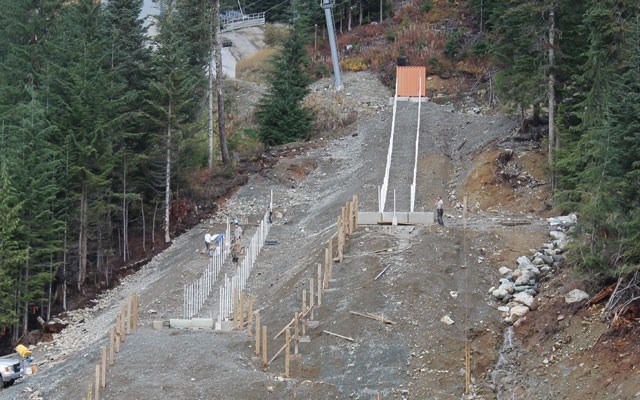Heavy rains on Dec. 10 and 11 caused debris to spill onto new ski jumps being constructed at Whistler Olympic Park.
The new jumps were nearly completed at the time the debris fell onto them and while little damage to the project was sustained, according to the park's manager of Nordic sport, John Heilig, there is still a significant clean-up cost. Though the final tally isn't yet in, Whistler Sport Legacies president and CEO Roger Soane estimates the cost will wind up being in the neighbourhood of $50,000.
"We were very lucky, actually. It came down the side of the slope and just sort of washed in front of the ski jump," he said. "I would imagine, by the end of the day, it's around a $50,000 clean-up bill."
Both Soane and Heilig stressed the debris — primarily trees and loose gravel — tumbled from well up the hill, with Heilig referring to the event as an "act of God."
"It was above the ski jumps by a few hundred metres," Heilig said. "There was a bit of a landslide up there and the debris landed on the hill. We basically had to take all the debris off. Everything else was generally in pretty good shape, but it took about a week to remove the debris.
"The slides had nothing to do with the site, we just ended up being the deposition zone."
Per Environment Canada, 122.8 mm of rain fell in Whistler from Dec. 9 to 11, with 70.3 mm falling on Dec. 10 alone.
Soane stressed a geotechnical study was completed before construction began and there was nothing in it to warrant red flags. He added work on the jumps was not responsible for the slide.
"When I first heard about it, I was concerned it was something we may have triggered from building the new jumps, but it was nothing in that regard. It was just a natural water flow that was further up the hill," he said. "(With) that torrential rain we had over those couple of days, it just let go as it does sometimes."
A geotechnical report the day after the slide gave Soane some food for thought as things progress.
"It advised us on the stability of the hill and advised us what we should be doing in the future," he said. "There's a little bit of clean-up work that we'll do at the top of the hill when the snow's gone, but right now, we've had an all-clear from the engineers that the slopes are stable and there's nothing to worry about."
Soane said as a result of the report, WSL will clear dead trees and other debris this spring. They may also look at building a culvert, though the report did not make mention of that option.
Heilig said a few metres of plexiglass toward the end of both the 20m and 40m runs as well as landing hill boards were damaged and replaced. Temporary landing hill boards will be used this season and permanent boards will be installed in the spring.
"It's not a big challenge to do those temporarily," Heilig said. "All it does is it defines the sides of the slopes."
Heilig explained while the occurrence was certainly unwelcomed, the jumps' planned mid-January opening is still intact and will coincide with FIS World Snow Day.
"It's a bit frustrating, but we haven't had enough snow yet to use it anyhow, so it doesn't set us back," Heilig said. "Our first planned usage is a gelande jumping activity on Jan. 18."
The learn-to-jump event will take place from 1 to 3 p.m. at Whistler Olympic Park.




